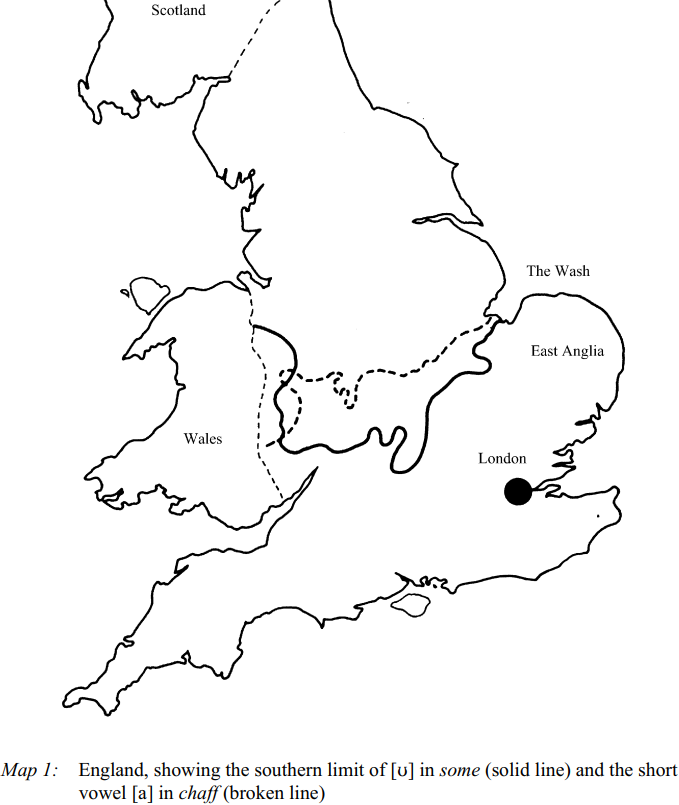


 Grammar
Grammar
 Tenses
Tenses
 Present
Present
 Past
Past
 Future
Future
 Parts Of Speech
Parts Of Speech
 Nouns
Nouns
 Verbs
Verbs
 Adverbs
Adverbs
 Adjectives
Adjectives
 Pronouns
Pronouns
 Pre Position
Pre Position
 Preposition by function
Preposition by function 
 Preposition by construction
Preposition by construction
 Conjunctions
Conjunctions
 Interjections
Interjections
 Grammar Rules
Grammar Rules
 Linguistics
Linguistics
 Semantics
Semantics
 Pragmatics
Pragmatics
 Reading Comprehension
Reading Comprehension|
Read More
Date: 2024-03-02
Date: 2024-04-23
Date: 2024-03-14
|
According to Trudgill in his The Dialects of England (1999), the major dialect boundary in England today is the line separating the North from the South. This line also has an acknowledged folk-linguistic status since it is used “informally to divide ‘southerners’ from ‘northerners’”. In linguistic terms, it consists of two major isoglosses marking the northern limit of two historical developments which are referred to by Wells (1982) as the FOOT-STRUT split and as BATH broadening. The FOOT-STRUT split is a sound change by which the Middle English short vowel u underwent a split resulting in phonemic contrast between  and [Λ] in words such as put and putt. The term BATH broadening refers to a historical process by which /a/ preceding a voiceless fricative, a nasal + /s, t/, or syllable-final /r/, was lengthened (e.g. from [baθ] to [ba:θ]) in the late 17th century, and then later retracted to [a:] (giving [ba:θ]) sometime in the 19th century. These changes mark the vowel systems of the South but are absent from the North. Local accents in the South therefore tend to have separate phonemes for the vowels in FOOT and STRUT and a long (in popular terminology “broad”) vowel /a:/ in BATH. Their northern counterparts have the same vowel –
and [Λ] in words such as put and putt. The term BATH broadening refers to a historical process by which /a/ preceding a voiceless fricative, a nasal + /s, t/, or syllable-final /r/, was lengthened (e.g. from [baθ] to [ba:θ]) in the late 17th century, and then later retracted to [a:] (giving [ba:θ]) sometime in the 19th century. These changes mark the vowel systems of the South but are absent from the North. Local accents in the South therefore tend to have separate phonemes for the vowels in FOOT and STRUT and a long (in popular terminology “broad”) vowel /a:/ in BATH. Their northern counterparts have the same vowel – – in both FOOT and STRUT, and a short front (“flat”) /a/ vowel in BATH. According to the Survey of English Dialects (SED), the FOOT-STRUT isogloss runs from the Severn estuary in the West to the Wash in the East. The BATH isogloss follows a similar path, but at its western end starts somewhat further south, crossing the FOOT-STRUT line in Herefordshire, then continuing to run north of it up to the Wash.
– in both FOOT and STRUT, and a short front (“flat”) /a/ vowel in BATH. According to the Survey of English Dialects (SED), the FOOT-STRUT isogloss runs from the Severn estuary in the West to the Wash in the East. The BATH isogloss follows a similar path, but at its western end starts somewhat further south, crossing the FOOT-STRUT line in Herefordshire, then continuing to run north of it up to the Wash.

|
|
|
|
التوتر والسرطان.. علماء يحذرون من "صلة خطيرة"
|
|
|
|
|
|
|
مرآة السيارة: مدى دقة عكسها للصورة الصحيحة
|
|
|
|
|
|
|
نحو شراكة وطنية متكاملة.. الأمين العام للعتبة الحسينية يبحث مع وكيل وزارة الخارجية آفاق التعاون المؤسسي
|
|
|